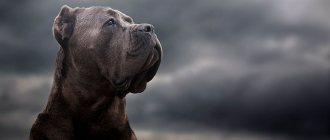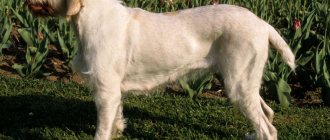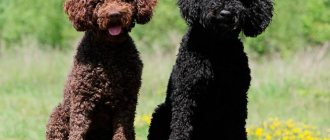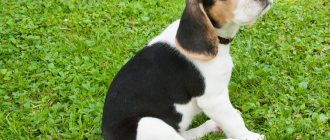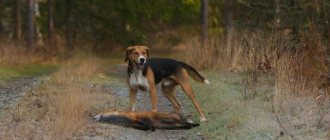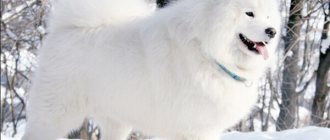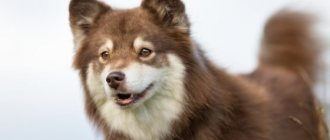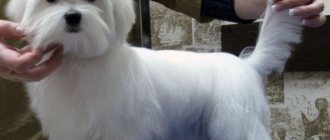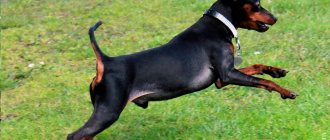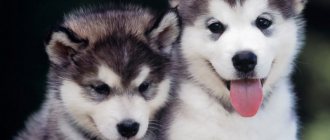History of the breed
Numerous researchers agree that dogs of this breed existed already in the 5th - 6th century BC. The ancestors of these cops were Mesopotamian molossoids and Egyptian lauriers. Mentions of hunting with the help of these dogs were found in Pliny and Xenophon, and images of similar dogs were found on Phoenician frescoes.
In the Middle Ages, these dogs gained great popularity among the aristocracy of Italy, they were bred by the most famous Italian families Medici and Gonzaga . Brakkas were used during bird hunting, the special skill of these dogs was that they knew how to bring game without spoiling it, for which they received the nickname “dogs with a soft mouth”, this feature made them the most preferred hounds in falconry. A brakk puppy was considered a very generous order among the nobility.
In the 18th century, the first club of Italian Bracca lovers was created in Italy, but soon these dogs began to be replaced by other hunting breeds and at the end of the nineteenth century these dogs were on the verge of destruction, the breed was saved by the Italian breeder Ferdinando de Ferrabucu, who first tried to standardize the breed. The final breed standard was adopted in 1949, and 17 years later the breed was recognized by the International Federation of Cynologists.
It is a pity that Italian Pointers, these proud, beautiful aristocrats, are so little common in our country today. According to various ratings, surveys and competitions at international dog shows, the Bracco Italiano is often recognized as the most beautiful breed among the entire diversity of the canine world. She is superbly built, spectacular, charismatic, impeccable in her movements, noble as a royal person, hard as steel in her work and gentle as a spring sunbeam in everyday communication. Bracco Italiano will decorate any interior - from a palace to a beggar's hut - and not only with its beauty, but also with its friendly optimism, devotion and loyalty to its owners, whom the dog adores to the point of madness. Atlas of dog breeds Dogs for sale Dog kennels Dog food Dog training
According to the FCI classification, the Bracco Italiano belongs to the VII breed group of dogs: continental and island pointers. All pointing dogs take an active part in the hunting process; at the same time, they are not capable of driving or poisoning the animal, but they spend long hours tracking down prey even in the harshest conditions, giving the owner a sign with a characteristic stance, hiding so as not to frighten off the future trophy. The ability to spy has been developed by cops over many centuries. It is clear that such a four-legged friend of the hunter had to have flexible thinking, iron endurance, the ability to make independent decisions, obey the owner and help him in every possible way, as well as the highest intelligence. This is what Bracco Italiano demonstrates to us even in today’s realities of life.
A Brief History of Bracco
Presumably, Italian pointing dogs descended from two ancestors: Molossians and ancient Egyptian dogs. If we recall the history of hunting dog breeding in general, then pointing breeds began to be bred by humans relatively recently: since the early Middle Ages. This was directly related to our history, because initially hunting was not entertainment, but a means of subsistence for ancient man, gradually, as the quality of life grew, turning into a valiant, gambling and spectacular “sport.” Over the centuries, the game brought home also becomes more varied and delicious. The goals of hunters are already different: not only to feed their tribe, avoiding starvation, but also to enjoy both the process of hunting and the taste of the meat obtained, and the hunting trophy itself is the joy and pride of every hunter. Therefore, it is logical to assume that hunting with cops should have originated precisely in southern countries with a mild, hot climate in which one can live well, and not “survive,” and where the local fauna is rich in the diversity of species and its numbers. Namely – in Italy and Spain. Initially, the ancestors of most hunting breeds in Europe (including pointers) were long-haired dogs, which in different countries and in different eras were called “Hispanioles”, “Spaniards” and other similar words (from which the name of the spaniel breed later came). Over the course of many centuries, hunting dog breeds have developed in a very interesting and diverse manner. Breeders (feudal lords and the people serving them) were engaged in breeding each breed in accordance with the climatic conditions and traditions in a particular area. It even happened: on a certain plot of land belonging to one or another noble family, for dozens of generations there existed a large population of the same type of dog, which could already be called a virtually full-fledged breed. Alas, many of them have sunk into oblivion, but some have transformed into established breeds and breed groups that have not changed to this day. Long-haired pointers were not suitable for every type of hunting and not for every landscape, so to create the short-haired pointer breed, both long-haired dogs and lop-eared hounds, exported from Asian countries during the era of the Crusades, were used. Animals with short hair were more resilient, had excellent sense of smell, could tolerate heat better, and were easier to care for. Let us quote an excerpt from the article “Hunting with Dogs” (N.N. Vlasov, A.V. Kamernitsky, I.V. Medvedeva): “Short-haired pointers with a stand, suitable for any bird hunting, appeared in Spain in the 15th – early 16th V. One of the old Spanish breeds of short-haired pointers was called “Perro de Punta” - a dog on a stand. In Italy, such dogs have been known only since the end of the 16th century. The name of the old Italian breed of short-haired pointers “Bracco Italiano” - “Italian Bracque” - has survived to this day.” For many centuries, the breed was bred and improved for only one purpose: to hunt birds with nets (snares). However, with the invention of firearms, the Bracco Italiano also proved itself to be an excellent gun dog. It’s hard to believe, but Braccos were perfect for falconry, and are still used in it to this day!
The official breed standard began to be developed in 1882, was finally adopted in 1926, and has remained virtually unchanged since then. Apart from Italy, Bracco Italianos have been and remain very popular dogs in the UK. However, there they are used not so much for hunting, but as a universal breed: they are a companion, a rescue dog, a police dog, an athlete, a therapy dog used in working with children, the sick and elderly, and a guide dog for the blind people, etc. The first representative of Bracco Italiano in Russia came out into the world at the Eurasia-1998 dog show. She was a luxurious stud bitch, but her owner soon emigrated to Finland, where she continued to engage in breeding activities, but the development of the breed in our country stopped for several years. At the moment, it is possible to purchase a Bracco puppy only in the “Feel of pride” nursery (Moscow). Perhaps, after getting to know the breed better, looking at beautiful photographs and talking with the few owners of these dogs on the Internet, among you, dear readers, there will be someone who will be attracted by the brilliant prospect of becoming the founder of the breed in our city.
To the future owner of Bracco
The Bracco Italiano is not a dog suitable for a novice owner. If you dream of having a representative of this particular breed, it is better that you have at least basic communication skills with a dog, preferably a hunting one. Bracco is perfect for a city apartment as a companion dog only if you walk a lot and exercise with your pet. Bracco Italiano requires more than just walking: he needs regular training with elements of free walking without a leash. In this case, the dog must unconditionally obey the owner and follow all his commands. But Bracco will most likely have no problems with obedience. But we should not forget that Italian Pointers are quite capricious and stubborn (despite the fact that they do not like to be mischievous and conflict with the owner, however, the dog often tries to show willfulness, as if to break out of control, misbehave or insist on its own). Most dogs have their own “zest”, their own unique character and style of communication, a unique psychological portrait, a certain collective image that characterizes a particular breed. Perhaps for Bracco Italiano this will be the duality of his nature: your pet will constantly amaze you how such opposite qualities coexist in him. The beauty and grace, the lazy phlegmatism of Bracco, sitting on the sofa like a chiseled figurine, can mislead an outside observer who has no idea how much inexhaustible energy and pranks lurks in this seemingly impenetrable creature. However, Bracco is not hysterical, not subject to sudden changes of mood: he is the same in all his guises. The same applies to the willfulness already mentioned in Bracco Italiano: yes, it is undoubtedly present, but in a bizarre way it is combined with a passionate desire to please the owner, to please him. Even showing miracles of resourcefulness, achieving his goal, the pet will not for a minute stop loving you with all the tenderness of a big dog’s heart. Bracco treats strangers without malice, but with caution. He is not suitable as a guard, but he senses any danger long before it arises, which he tries to warn the owner about in all ways available to him. But if a person came to the house with good intentions (not necessarily your friend!) Bracco will immediately flare up with unearthly enthusiastic friendliness towards him.
True, there is one more feature to the portrait of the controversial Bracco Italiano: his jealousy. Get ready for the fact that a pet, seemingly calm and restrained, will suddenly begin to be jealous of you for any living creature or event: “intervene” in a conversation, demand attention, prevent you from making phone calls or caring for other animals, etc. .d. And many such examples can be given. In Bracco Italiano, it’s as if two personalities “sit”, and where one begins and the other ends, and under what circumstances the dog will behave this way and not otherwise, can only be predicted... by being its owner! The experience of communicating with Bracco is very interesting. However, as we have already said, the future owner will need some dog training skills and a steady hand. In no case is it the punishing finger of fate, but rather the strong will and strength of an individual who knows how to combine an affectionate and respectful attitude towards a pet with a decisive “no”. To curb your pet's willful nature without punishing your beloved creature or humiliating its complex feelings, you will need experience and great patience. Therefore, Bracco is in no way suitable as a gift for a child! Yes, this dog can (and should!) be made a friend for the whole family, but get ready for the fact that all responsibility for its care and education will fall on you, the adults.
Features of Bracco content
Caring for the Bracco Italiano, like all short-haired dogs, is ridiculously simple.
Bracco wool should not only be neat and shiny - it should also be very pleasant to the touch. On forums, in the comments, you will come across such epithets when describing Bracco, such as “velvet”, “delicate”, plush”, “suede”, etc. Pay close attention to the hygiene and condition of your pet's ears: they should be clean, without the slightest sign of inflammation or skin irritation. In principle, the Bracco Italiano is a very healthy and strong dog. But, to be on the safe side, before breeding your pet, be sure to undergo genetic tests to determine the manufacturer’s predisposition to dysplasia of the joints of the limbs and eye diseases. The average life expectancy of a Bracco Italiano is about 12 years or more. Anna Bolodurina
The editors express their gratitude to the breeder Natalia Dunaeva, owner of
the “Feel of Pride” nursery for the photographs provided. E-mail: [email protected] , phone
Dogs
Collection of articles about dog breeds with descriptions and photographs
Cops, stories and descriptions of breeds, nurseries
Bracco Italiano - Italian Pointer
Exterior of the breed
The Italian Barak is a very harmonious dog, with well-developed muscles. The length of the body is, as a rule, slightly greater than the height at the withers. The height of males is 57 -67 cm , females - 55 -64 cm , weight, respectively, 27 -40 kg and 24 -37 kg .
The head is not large, wide, the transition from the forehead to the muzzle is poorly defined. The nose is large, slightly protruding, the color ranges from bright pink to brown depending on the color of the coat. The eyes are large, oval in shape, and the color can range from light to dark brown. The ears are hanging, long, slightly rounded at the ends, strictly turned inward. The neck is of medium length, powerful with slight dewlap. The body has a slightly square shape, the chest is deep and quite wide. The back has well-developed muscles, the stomach is slightly tucked. The fore and hind limbs have well-developed prominent muscles and are quite long. The paws are oval in shape, the toes are tightly clenched, and the dewclaws are present. The claws are very strong and light in color. The tail is docked in childhood; the length should not exceed 25 cm.
Brakki are short-haired dogs, the hair is very thick and shiny, shorter on the head and ears than on the body. The color can be white with spots of various shapes of dark or light brown, or coffee piebald with specks; a symmetrical mask on the front part is welcome.
Choosing a puppy
The Bracco Italiano breed is very popular; anyone who is interested in cops and hunting probably knows about these dogs. It is simply impossible not to recognize the baby - even at a very young age he will look like his parents. The breed can be recognized by its large paws and long ears located on the sides. The puppy should not be overly aggressive or fearful; poise and calmness are typical traits. But reliable confirmation will be a document - an official pedigree, without which the dog’s belonging to specific roots can only be judged tentatively.
We recommend reading: Pet IQ: the smartest cat breeds
The Italian Bracque breed can be recognized even in small puppies
To purchase a puppy, you must contact a specialized nursery that specializes in this breed. You will have to spend money on a good representative, the average price tag is 800–1000 euros.
The average cost of Italian Bracco puppies is 1000 euros
Character
The Italian Bracca is a very energetic and active dog . That is why, in the absence of exercise, the dog can become disobedient. They are very hardy and scrupulous in their work; they feel great both on land and in swamps and lakes.
Bracias are very devoted and faithful pets; they quickly get used to their family and establish close relationships with all its members. These dogs love older children more, as they can keep them company in the game, and they are neutral towards small ones, but will never offend the baby. An Italian pointer should not be left alone for a long time or simply ignored; the dog can become very offended and become stubborn. These dogs are very curious, and despite the fact that they perfectly see and hear what is happening around them, they are not suitable as guard dogs, they are too friendly.
Brackies are very smart dogs; they instantly grasp everything on the fly, as soon as they see it, so they quickly learn to open doors and pull out the things they need.
Description of the breed
This dog needs regular exercise. He is very active, strong and agile. Don’t even think about getting such an animal in a city apartment. Only those owners who have a flexible work schedule or can afford not to work at all can afford this luxury.
They will have enough time for a morning run with their beloved pet, sports activities in the afternoon and a long walk in the evening. Otherwise, the dog’s character will deteriorate, and the property in your home will deteriorate.
They are very attached to the family in which they grow up. The constant need for communication and friendliness make them vulnerable during periods of loneliness.
They have a very hard time with separation and are bored so much that they can even get sick. They prefer children aged seven years and older as their playmates. They are not interested in babies, and the pet will simply ignore the baby trying to climb on it.
As for guard skills, more can be said about their lack than about how to make a guard out of Bracco. Although experienced trainers probably know the secrets of properly raising a pet. The Italiano has such an impressive and serious appearance that it will be difficult for an outsider to see him as a kind and sympathetic creature, so that if he spots your family pet in the yard, not a single thief will want to get inside.
Care and education
When training, you should not treat the dog harshly or punish it without reason. Training should be built on patience and consistency; if the dog does not undergo early socialization, it may become too stubborn.
Brakk can live in a city apartment, but it is important not to forget about good physical activity - at least two walks for an hour. And if the dog lives in the countryside, then he will be happy to run through the forest.
Caring for a dog's coat is quite simple. To remove dead hair, it is enough to brush the dog twice a week with a hard brush or rubber glove; you do not need to bathe too often, since these dogs do not get very dirty. The dog's long ears require special care; they need to be cleaned regularly using special products.
Education and training
The Italian Braque is easy to train.
The dog needs character development and socialization. Education and training must begin at an early age and be dealt with systematically. The Italian Braque is easy to train and easily learns the meaning of commands. The dog does not accept rough and cruel treatment. When raising a dog, the owner needs to be persistent and patient.
Nutrition
Italian Braccas are unpretentious eaters . They can eat both premium dry dog food and natural products. If the dog eats natural food, then it is important that it is based on proteins - lean meats, boiled fish. The diet should also include:
- Milk and cottage cheese.
- Eggs.
- Vegetables, greens.
- Porridge (rice, wheat, oatmeal).
The dog must have constant access to drinking water. These dogs are quite gluttonous and if you do not watch the portions, the dog may suffer from obesity.
It is not advisable to feed table scraps, since salt and other spices and seasonings are contraindicated for the dog. Also, the diet should not contain:
- Sweets and pastries.
- Smoked and marinated dishes.
- Tubular bones.
Maintenance and care
The Italian Pointer has a short, coarse coat and does not require frequent washing. It is enough to bathe the dog once every 2-3 months. Bracket's skin is very sensitive, if you use a special shampoo for dogs, it should be diluted 5 times. During a walk, the dog moves actively, its coat is often dirty, and the breed is prone to heavy shedding. For fur, you need to have a rubber brush and brush your pet daily.
A dog's ears are designed in such a way that lack of ventilation often leads to the development of inflammatory processes. Care includes regular cleaning of the ears with medicated lotion and removal of excess wax.
The cop's eyes are covered with loose eyelids and tend to become inflamed. From time to time, the mucous membranes are washed with eye disinfectants, making movements directed towards the inner corner of the eyeball.
On a note! Dogs, like humans, can develop caries and develop tartar. Buy the animal a toothbrush and toothpaste in a specialized store, brush its teeth every 2-3 days, removing the soft plaque.
Health
Italian hounds are considered a healthy breed; centuries-old selection has given them quite strong immunity. On average, representatives of this breed live 12-13 years . However, they are predisposed to the following diseases:
- von Willebrandt disease,
- Dysplasia of the hip and elbow joints,
- Volvulus.
Don’t forget about the need to vaccinate your Italian Bracket, since no dog is immune from infectious diseases.
Health and life expectancy
In general, Italian Braccas are distinguished by good health and live up to 13 years, and sometimes more. The breed is characterized by the development of certain diseases:
- eye diseases;
- ear diseases;
- problems with joints (hip, elbow);
- kidney pathologies;
- gastric volvulus;
- von Willebrand's disease.
Note! With proper care and timely prevention, diseases and other problems can be avoided. It is worth remembering regular vaccination and antiparasitic prevention.
Photo of Italian Braccus
Origin story
The Italian Braccus is considered one of the oldest pointing dogs. The first mentions of it were found in the 4th-5th centuries.
What were Bracco Italiano used for?
Australian Kelpie (dog breed): description
Dogs of this breed were most often used in hunting. They became especially popular in the Middle Ages in Italy. These dogs were bred by such celebrities as Medici and Gonzaga. The Italian Braccus is a dog that was often used for bird hunting.
Note! The love for dogs as hunters also increased because they brought game without damaging it at all.
The influence of the Italian Braccus on other types of dogs
The Italian Bracket had a rather serious influence on the development of other breeds of gun dogs. Almost all of the following types take on some of the characteristics of a given dog (German, French Braque, etc.). The only exceptions are quite old breeds - Portuguese Pointer, Weymoraner, Vizsla, and some types of spaniels.
The entry of Italian bracca to the international level
The Fédération Cynologique Internationale recognized the breed in 1956, and the first standard was adopted in 1949 in Italy. The English Kennel Club recognized the Italian Braccus in 2000.
For your information! Clubs in the USA, despite the high popularity of the breed, still do not recognize it and classify it as a rare species.
Popularization of Bracco Italiano
Currently in Italy this breed is the most common of all gun types. The Italian Bracket often appears at sled dog races, various rings and shows, and exhibitions. In 1989, the dogs were brought to the UK. However, recently the breed is often found in the West. Dogs have become very popular in the USA.
The impact of industrialization on Bracco Italiano
The Brakk is a dog breed that was rapidly developing even before the advent of firearms. Bird hunting was very popular in Europe at that time. Falcons and nets were used for this purpose. With the advent of guns, they were no longer needed. However, now the hunters had to look for the killed prey themselves. Hunting dogs were used at that time for flushing and searching for killed game. Therefore, the Italiano Bracco began to be used more often, and the breed gradually became the oldest of the hunting ones.
Italian Bracchis are passionate and love to hunt.
Spinone Italian
This breed originated in medieval Italy. But this breed is very popular in Italy because it is an excellent hunter; as for popularity outside the country, it is very low. By nature, this is a very fighting and strong dog. But she also doesn’t mind having fun with the kids. Their height reaches up to 70 cm and weight up to 37 kg.
